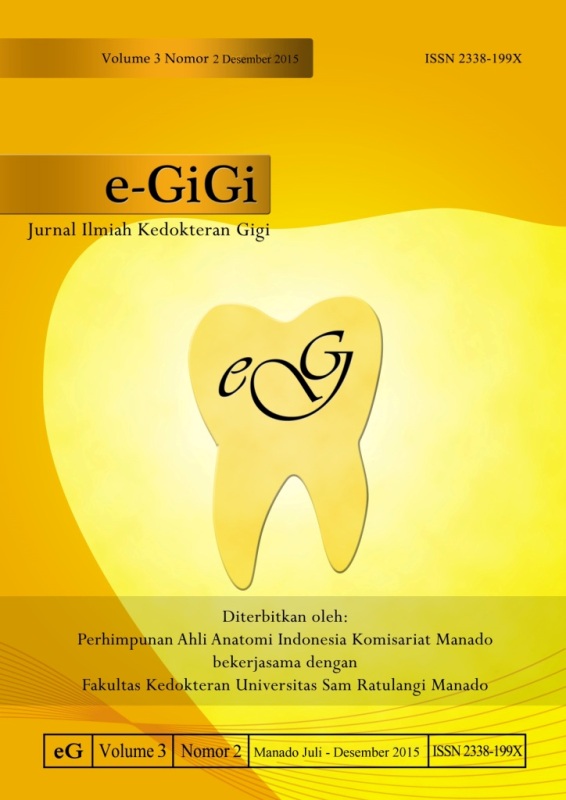UJI PELEPASAN LOGAM KROMIUM (Cr) DAN NIKEL (Ni) BEBERAPA MEREK BRAKET STAINLESS STEEL DALAM CAIRAN SALIVA ARTIFISIAL
DOI:
https://doi.org/10.35790/eg.3.2.2015.9637Abstract
Abstract: Stainless steel bracket, a popular fixed orthodontic appliance containing chromium and nickel, is used most frequently in fixed orthodontic treatment. Stainless steel bracket interacts with oral cavity environment and causes metal corrosion process. The released chromium and nickel due to the corrosion process can get into the body and cause hypersensitivity reactions. This study aimed to determine the release of chromium and nickel from stainless steel bracket in artificial saliva. This was an experimental laboratory study with a quasy experimental and nonequivalent control group design. Samples were analyzed by using spectrophotometry ultraviolet visible (UV-Vis) to determine the releasing of chromium and nickel. There were 4 kinds of stainless steel bracket immersed and stored in artifisial saliva at 37oC for 30 days. The result showed that each sample varied in the release of chromium and nickel from stainless steel brackets in the artificial saliva. Sample A had 0.025 ppm chromium and 0.689 ppm nickel; sample B had 0.002 ppm chromium and 1.012 ppm nickel; sample C had 0.008 ppm chromium and 1.130 ppm nickel; and sample D had 0.027 ppm chromium and 1.176 ppm nickel. The release of nickel of each sample was higher than of chromium. There was no specific pattern of the release of chromium and nickel due to the different composition of stainless steel brackets which depend on the manufacturers.
Keywords: stainless steel bracket, chromium, nickel, spectrophotometry UV-Vis, artificial saliva
Abstrak: Braket stainless steel sering digunakan dalam perawatan ortodonti cekat yang umumnya mengandung kromium dan nikel. Braket stainless steel akan berinteraksi dengan lingkungan dalam rongga mulut sehingga menyebabkan proses korosi. Pada proses korosi terjadi pelepasan logam kromium dan nikel yang dapat masuk ke dalam tubuh dan dapat mengakibatkan reaksi hipersensitivitas. Penelitian ini bertujuan untuk mengetahui besarnya logam kromium dan nikel yang terlepas dari braket stainless steel dalam cairan saliva artifisial. Penelitian ini menggunakan metode eksperimental laboratorik dengan jenis penelitian pra eksperimental serta desain penelitian nonequivalent control group design. Sampel diuji menggunakan spektrofotometri UV-Vis untuk mengetahui pelepasan logam kromium dan nikel. Sampel terdiri dari 4 macam merek braket direndam dalam larutan saliva artifisial selama 30 hari pada suhu 37oC. Data hasil penelitian diolah menggunakan komputerisasi. Hasil penelitian menunjukkan terdapat pelepasan logam kromium dan nikel dalam saliva artifisial yang bervariasi di tiap sampel. Sampel A memiliki pelepasan kromium 0,025 ppm dan nikel 0,689 ppm; sampel B memiliki pelepasan kromium 0,002 ppm dan nikel 1,012 ppm; sampel C memiliki pelepasan kromium 0,008 ppm dan nikel 1,130 ppm; dan sampel D memiliki pelepasan kromium 0,027 ppm dan nikel 1,176 ppm. Pelepasan nikel pada tiap sampel lebih tinggi dibandingkan dengan pelepasan kromium. Hasil penelitian tidak menunjukan pola tertentu, hal ini dapat disebabkan karena komposisi yang berbeda-beda dari braket stainless steel tergantung ketentuan masing-masing pabrik pembuatnya.
Kata kunci: braket stainless steel, kromium dan nikel, spektrofotometri UV-Vis, saliva artifisial
Downloads
How to Cite
Issue
Section
License
COPYRIGHT
Authors who publish with this journal agree to the following terms:
Authors hold their copyright and grant this journal the privilege of first publication, with the work simultaneously licensed under a Creative Commons Attribution License that permits others to impart the work with an acknowledgment of the work's origin and initial publication by this journal.
Authors can enter into separate or additional contractual arrangements for the non-exclusive distribution of the journal's published version of the work (for example, post it to an institutional repository or publish it in a book), with an acknowledgment of its underlying publication in this journal.
Authors are permitted and encouraged to post their work online (for example, in institutional repositories or on their website) as it can lead to productive exchanges, as well as earlier and greater citation of the published work (See The Effect of Open Access).






